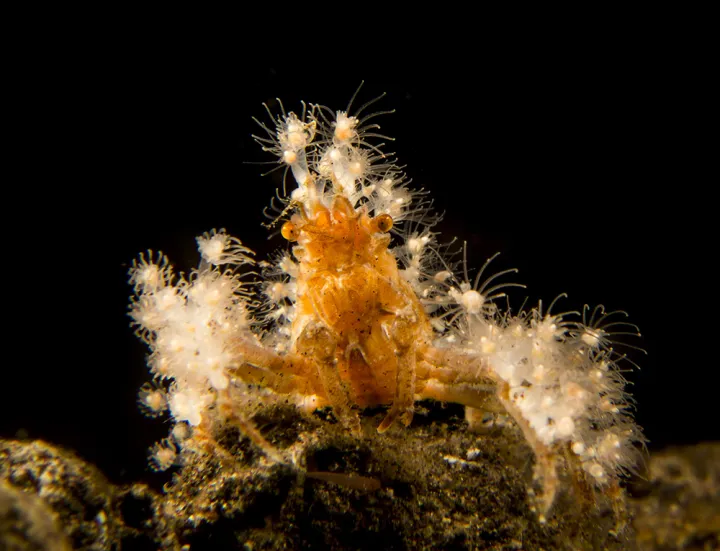Happy Crabby Holidays

Like a store owner in December, a decorator crab can transform the back of its shell into a beautiful display. Only instead of twinkling lights and glittering ornaments, it chooses from a variety of sea sponges, tufts of algae and other bits and pieces of detritus for the decorations. The task is made easier by tiny hairs (called setae) on the body and legs that act like Velcro.
Of course crabs don’t celebrate Christmas, so why, then, is this little guy dressed up in a festive pom-pom getup fit for one of Santa’s elves? Thank the scientists who did some experiments to find out more about what influences the decoration choices these crabs make. Despite the crab’s cringe-worthy style, their results suggest that the outfit could actually be an attempt by the crab to blend in.
Scientists have long known that decorator crabs adorn their backs and legs with objects from the environment, but they still aren’t completely clear why. The theory is that it has to do with avoiding being eaten. The mottled mosaic of decorations acts like an army camouflage uniform, helping the crab avoid detection. But even if spotted, the decorations may still act as a defense. A crab is a tasty meal, but with a sauce of algae, sponges, or even detritus–not so much. Some algae and sponges even produce noxious chemicals, suggesting crabs could be choosing certain decorations based upon their repellant qualities.
To get a better sense of how the environment affects a crab’s decoration technique, researchers at the University of Delaware did an experiment where decorator crabs called Camposcia retusa were observed adorning themselves. But instead of the normal, tried and true disguises (algae, sponges, etc.) whose variety might influence the crabs’ choices for reasons such as odor or texture, they were given polyester pom-pom balls straight from the craft store. The scientists started off with red and green pom-poms but in the final experiments settled on red ones that only differed in size.
Left with a weird array of decorations, the crabs did what they do best—they stuck them on their body, covering themselves head to toe (er, claw).
The crabs began picking up pom-poms almost immediately. Such speedy decoration is a sign that they’re doing it quickly to avoid predators. They also showed a preference for certain pom-pom sizes and parts of their bodies. Most of the pom-poms were placed on the strong back walking legs, and these were the only locations where the crabs put larger pom-poms. It appears the crabs are prioritizing body parts that are most often exposed and best able to carry the weight of decorations. Also, having a bulky body makes it difficult to escape agile predators or fit into a small hideout. In one experiment, half the crabs were given shelter and half were not. The crabs without shelter used 17 percent more pom-poms, again suggesting that the decorations are used to reduce the chances of being eaten.
Now that the scientists can confirm that the crabs don’t mind using pom-poms as decorations, they are designing experiments that will determine whether visual or chemical disguises are the primary motivation to decorate. Humans rely heavily on visual cues so it’s easy to assume that the decorations are primarily used as a disguise, but perhaps smell is more important underwater. Future experiments will not only experiment with pom-pom color preference but will also include slathering various chemicals onto the pom-poms to see if odor plays a part.
At the moment, though, I can’t help but notice the similarities between the crab’s attire and my outfit for an upcoming ugly sweater party. Happy Holidays!



